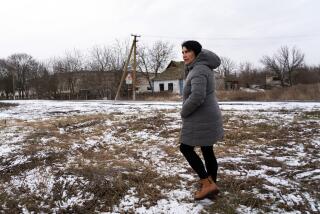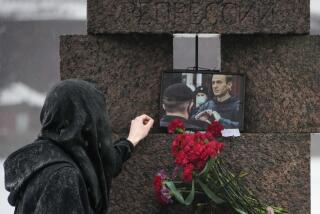Russia’s Lost Children
- Share via
KRASNOYARSK, Russia — Every day, Oksana Korshunova drives to the 9-foot-deep sewage pipe about a mile from her house. She squats on the rim and stares into the charred hole, straining to imagine how her son, Maxim, got down there and what happened to him before he did.
She has gone over it day and night for weeks, a hideous loop of film that keeps replaying in the back of her brain.
The 11-year-old came home from school, then dashed out to play with his friend Sasha from downstairs. It was 4 p.m., possibly 4:30, on April 16. How many times had Korshunova watched absently as her only son shuffled out the door? Listened to the boys’ shouts and giggles filtering up through an open window, then dwindling into the distance as they picked up reinforcements and went over to the schoolyard to swing?
That evening, when Maxim didn’t come home for dinner, Korshunova went down to the courtyard, blinking into the empty dusk. She wasn’t alone. Sasha’s parents, Larisa and Pyotr Lavrenov, came down about the same time. Then the parents of Safar Aliyev, Galash Mamedgasanov and Dmitry Makarov walked up. None of the five boys had returned that evening.
The parents alerted the neighbors and split up the work. They looked through all the neighboring courtyards, went up to the school, fanned out into the nearby junkyards and industrial plants. Three days later, police joined the search, making their way up to the river, even sending motorboats out to deserted islands.
Over the next few weeks, photographs of five skinny, smiling boys, ages 9 to 12, appeared all over Russia. After an all-points bulletin was issued, 18,000 police officers from Siberia to Moscow checked more than 15,000 basements and attics and more than 45,000 homes. Thousands of wells were inspected; a psychic was commissioned.
The mystery ended May 8, when a pile of small bodies, burned so badly that they were little more than blackened bones and fragments of bones, was found at the bottom of the empty concrete sewage well. Or perhaps, that’s when the mystery began.
There are only two possibilities, police say. The boys climbed down into the pipe themselves and accidentally touched off a firestorm of methane gas and old fuel oil, perhaps while sniffing aerosol fumes or trying to light a small bonfire. (This imagines five boys crowding into a space barely five feet in diameter.) Or they were killed somewhere else, and their bodies were torched in the abandoned collector.
It is part of post-Soviet Russia’s nightmare that there are many such mysteries, though few with such bleak endings. An estimated 30,000 children go missing in Russia each year, most of them runaways who flee the miseries of the nation’s underfunded orphanages or the homes of alcoholic or abusive parents.
In 2003, Russian authorities picked up 620,000 children wandering without supervision in the streets. More than 2,100 children were reported missing last year in Siberia’s 375,000-square-mile Krasnoyarsk region, home to 3.5 million Russians. Of those, 25 were found dead and 178 are missing.
Many runaways make their way to Moscow, where those as young as 10 or 12 can be found by the half-dozen in railway stations, basements and old bunkers. They forage for half-eaten hamburgers at fast-food outlets and stop passersby for spare kopeks or paid sexual assignations. Some can be seen simply standing on sidewalks crying.
“In most of these cases, these are not homeless children. They are neglected,” said Boris Altshuler, who heads the Moscow nonprofit group Right of the Child. “Neglected means their parents don’t give them food, they beat them. These children vote with their legs to leave the bad conditions of their families or to escape from an institution, and it’s very important to know that many of these children escape again and again.”
Yet few think of the boys in Krasnoyarsk city’s impoverished Leninsky neighborhood as runaways, though even parents acknowledge that the district’s “Blade Runner”-like landscape of hulking, old factories, slowly crumbling into oblivion, might be enough to drive any child toward greener playgrounds.
True, one of the boys had talked of leaving home and had even tried once. And although a burnt aerosol can was found near the bodies, their parents and teachers say there were no previous hints of substance abuse. By all accounts, the boys had attentive, loving parents and little inclination to wander far from their front doors.
“Boys will be boys, of course. But these were normal children. These children were well-bred, they had good manners. Their parents were very involved in their schooling,” said fourth-grade teacher Natalya Vikulova, who taught both Maxim and Sasha.
She pulled out a grade book and pointed to a long row of 5s and 4s, the equivalent of As and Bs, next to the boys’ names.
“There is nothing that can make me believe they ran away. And the children couldn’t just burn themselves up like that in the bottom of a [9-foot] hole. Five children together?” Vikulova said. “My personal opinion is that something horrible occurred.”
Deputy Prosecutor-General Vladimir Kolesnikov, visiting from Moscow to discuss the case, said May 14 that authorities were investigating it as a possible murder.
“We today cannot for sure establish the cause of death for every child. But the complexion of materials makes us believe that the case based on murder was opened correctly, with all the consequences connected with it,” Kolesnikov told reporters.
Police say it will be weeks before a positive identification can be made. But along with the bodies, police found a silver-plated chain like the one that held a tiny cross around Maxim’s neck, the key to Sasha’s apartment house door and a shoe and part of a sweater linked to some of the other boys.
“We believe that the remains that were found belong to the five children who disappeared on April 16. There’s no doubt about it,” Kolesnikov said.
As soon as the word “murder” came up, headlines began laying out various possibilities. Kidnapping by a gang of pornographic film producers or black-market organ dealers -- neither scenario, unfortunately, unimaginable in today’s Russia. The “maniac variant” was mentioned in several news reports.
Only last week, the charred bodies of two 13-year-old girls were found in the faraway city of Volgograd, and three men were arrested in the case. Here in Krasnoyarsk, the second-largest city in Siberia, police for years have been looking for a suspected serial killer responsible for leaving human body parts in various locations between 1999 and 2003, including the severed heads of two young boys.
Even the search for the missing boys turned up more than the police had bargained for: Search teams stumbled upon six other bodies, including that of a newborn child and two people who showed signs of violent deaths. They also discovered a 6-month-old child lying in a sewage pipe near a factory, nearly starved but alive.
In a neighborhood such as this one, it is not hard to imagine that almost anything might be found. A once-top-secret Soviet-era chemical plant, now closed, sits next to the apartments where the boys lived. Nearby are the city’s central heating plant, a tire factory and the factory where Larisa Lavrenova works the night shift, operating a machine that makes plastic ketchup bottles.
Most of the other factories have fallen into grand ruin. The road next to several adjoining apartment courtyards passes alongside enormous networks of rusting pipes, collapsed walls and broken mechanical hulks. The apartments themselves, originally built as Siberian labor camp housing in the Stalin era, are decrepit, chilly and badly lighted.
In such a place, an accidental explosion can’t be ruled out. Still, parents say, the children had never before been known to stray so far from home. Moreover, there would barely have been room enough for them to squeeze into the pipe, certainly not enough to sit down. There wasn’t even a ladder leading down into the pipe, though a burned log might have been used for climbing. Also, residents wonder, what kind of accidental fire would have burned so hot that it reduced their bodies to mere bones -- a fire that authorities say would have had to reach about 1,000 degrees?
It would have been possible, suggested Alexander Makarov, a reporter in Krasnoyarsk for the Moscow paper Izvestia, if the boys tried to light a fire in the sewage collector and it ignited gasoline or black oil seeping through the connecting sewage pipes.
“From my sources among the forensic experts, I received the information that when the children were burning, they were still alive,” Makarov said, “which makes the possibility of an accident quite high.”
Yet, the parents contend that both they and the police peered into the sewage collector and searched the yard around it with dogs several times in the days and weeks after the disappearance, and there was no evidence of a fire nor anything at all in the bottom of the pipe.
Police appear to be unsure whether the area was searched. Prosecutors said they were considering filing negligence charges against the police for their slowness in initiating a thorough search when the boys first were reported missing.
“I personally looked in the hole,” said Mageram Gasanov, a neighbor.
“It was daytime. I saw the bottom of the well. There was nothing there.”
But the murder theory also poses problems, authorities acknowledge. How could five strong, lively boys be rounded up in broad daylight with no one noticing?
Repeatedly, family members return to stories of a black car of a foreign make and with no license plate that a neighbor had seen in a nearby courtyard in the days before the boys’ disappearance.
That links up with the story told by a young boy who had been playing with the missing youngsters earlier in the day. He told police that he had gone to buy a loaf of bread for his mother, then returned to see a man with a submachine gun herding the boys into a black, foreign-make car. But when a doubtful investigator said, “Maybe you also saw flying saucers?” the boy said he had made the story up.
Now, family members and local journalists say, neither the boy nor his mother can be found. Parents of the missing boys say they believe the mother is afraid for her son’s safety.
Another problem in finding the truth, said Lavrenova, Sasha’s mother, is that much evidence may have disappeared in the time it took police to launch an investigation. “They didn’t take it seriously. They were confident that our children had simply run away for a better place to play and they would come back soon,” she said.
“How can they say that?” her husband asked. “Whenever he would ask for permission to go outside, I would say to him, ‘Where will you be?’ He would say either in the neighboring yard or the schoolyard. Because these are the nearest places where there are playgrounds.”
Korshunova said she has not slept for more than an hour or two at a stretch since Maxim went out that day. While her husband still tries to work at his security guard job, she and her mother sit for hours in their tiny living room in a tangle of overgrown tomato seedlings that no one has the heart to transplant outside. Every day, sometimes several times a day, she makes her way to the sewage collector and stares tearfully down inside, as if clues might be discerned somewhere on the blackened walls.
“Look at it yourself and see if it looks like a place a child would want to play,” she said softly.
“No. Something else happened.”
More to Read
Sign up for Essential California
The most important California stories and recommendations in your inbox every morning.
You may occasionally receive promotional content from the Los Angeles Times.










